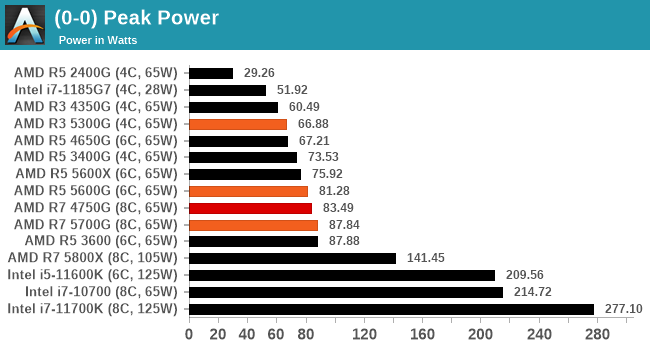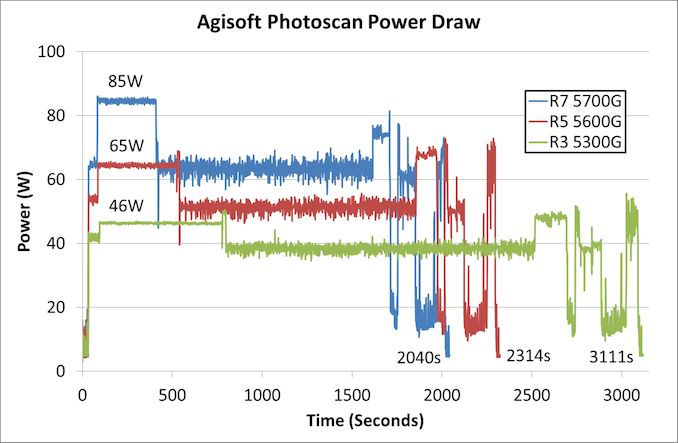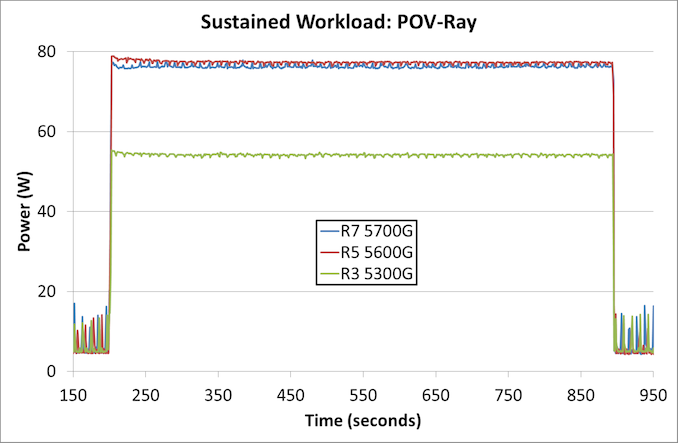The AMD Ryzen 7 5700G, Ryzen 5 5600G, and Ryzen 3 5300G Review
by Dr. Ian Cutress on August 4, 2021 1:45 PM ESTPower Consumption
The nature of reporting processor power consumption has become, in part, a dystopian nightmare. Historically the peak power consumption of a processor, as purchased, is given by its Thermal Design Power (TDP, or PL1). For many markets, such as embedded processors, that value of TDP still signifies the peak power consumption. For the processors we test at AnandTech, either desktop, notebook, or enterprise, this is not always the case.
Modern high-performance processors implement a feature called Turbo. This allows, usually for a limited time, a processor to go beyond its rated frequency. Exactly how far the processor goes depends on a few factors, such as the Turbo Power Limit (PL2), whether the peak frequency is hardcoded, the thermals, and the power delivery. Turbo can sometimes be very aggressive, allowing power values 2.5x above the rated TDP.
AMD and Intel have different definitions for TDP, but are broadly speaking applied the same. The difference comes to turbo modes, turbo limits, turbo budgets, and how the processors manage that power balance. These topics are 10000-12000 word articles in their own right, and we’ve got a few articles worth reading on the topic.
- Why Intel Processors Draw More Power Than Expected: TDP and Turbo Explained
- Talking TDP, Turbo and Overclocking: An Interview with Intel Fellow Guy Therien
- Reaching for Turbo: Aligning Perception with AMD’s Frequency Metrics
- Intel’s TDP Shenanigans Hurts Everyone
In simple terms, processor manufacturers only ever guarantee two values that are tied together - when all cores are running at base frequency, the processor should be running at or below the TDP rating. All turbo modes and power modes above that are not covered by warranty. Intel kind of screwed this up with the Tiger Lake launch in September 2020, by refusing to define a TDP rating for its new processors, instead of going for a range. Obfuscation like this is a frustrating endeavor for press and end-users alike.
However, for our tests in this review, we measure the power consumption of the processor in a variety of different scenarios. These include workflows, real-world image-model construction, and others as appropriate. These tests are done as comparative models. We also note the peak power recorded in any of our tests.
First up is our image-model construction workload, using our Agisoft Photoscan benchmark. This test has a number of different areas that involve single thread, multi-thread, or memory limited algorithms.
For the Ryzen 7 5700G, the most power-hungry part of the test is right at the beginning, where we’re seeing peaks of 85 W. For the 5600G, that first section goes to 65 W, but the peaks actually occur here near the end of the test. The 5300G also has peaks later in the test, but that first section is the lowest, running only at 46 W.
The second test is a sustained rendering workload.
In this instance, the Ryzen 3 5300G is nearer 55 W with a sustained workload over 10 minutes, while the Ryzen 5 and Ryzen 7 sit just below 80 W.
For peak power, we report the highest value observed from any of our benchmark tests.

While all three processors have a TDP rating of 65 W, by default on AMD systems the Package Power Tracking, which is the limiting factor here, is 88 W. The Ryzen 7 is practically at that value, while the Ryzen 5 just goes a smidge over 80 W. The Ryzen 3 on the other hand only matches its TDP in the worst-case scenario.












135 Comments
View All Comments
mode_13h - Monday, August 9, 2021 - link
> RAMBUS was supposed to unlock the true power of the Pentium 4I think Intel underestimated what the DDR consortium was capable of doing. Perhaps they were right, as the DDR makers were eventually forced to license some RAMBUS patents, as I recall.
> the Willamette I used for a decade had plain SDRAM, not even DDR.
Northwood was the best. Sadly, I bought a Prescott because I wanted hyperthreading and hoped the 2x L2 cache would compensate for the longer pipeline. But, it turns out you could even get hyperthreading and 800 MHz FSB, in a couple Northwoods. I also thought SSE3 might be useful, but never got around to doing anything with it.
BTW, I also used DDR400 in my P4.
GeoffreyA - Tuesday, August 10, 2021 - link
For me, both the Prescott and A64 were available, but I went with the latter because I always wanted an Athlon. Originally, was looking at the XP 3200+ and dreamt of coupling that with an nForce2 motherboard. As for Northwood, masterpiece of a CPU. P4 would have put up a respectable defence against the A64 had they continued with it. My aunt had a 2.4 GHz Northwood back then, and my school friend a 2.66 GHz one. His struggled at first, but once he got more RAM and a GeForce FX 5700, it really flew. Still remember running through Delta Labs in Doom 3 at 60 fps!mode_13h - Wednesday, August 11, 2021 - link
Prescott was rumored to have 64-bit support, though it wasn't enabled. I think that explains some of the additional pipeline depth.When Core 2 first launched, I was skeptical the IPC could increase so much that so much lower-clocked CPUs would really outperform their predecessors. It took me a little while to fully accept it. I was hopeful the final 65 nm iteration of Pentium 4 would finally let the Netburst architecture stretch its legs, but even that couldn't overcome its inefficiencies and other deficits.
GeoffreyA - Friday, August 13, 2021 - link
Quite likely. Come to think of it, didn't the Pentium Ds have x64? And they were Prescotts.Indeed, 65 nm might have taken Northwood further. Would've made an interesting processor which we'll never see. As for their 31-stage brethren, the 65 nm Cedar Mills dropped power a fair bit.
GeoffreyA - Friday, August 13, 2021 - link
"65 nm might have taken Northwood further"Well, we didn't even get to see a 90 nm one.
coolrock2008 - Wednesday, August 4, 2021 - link
Ryzen 5 APUs Table, there is a typo. the 5600G is listed as an 8 core part whereas its listed as a 6 core part in the previous table.Wereweeb - Wednesday, August 4, 2021 - link
I know how hard it is to actually publish something that is both excellently researched and at a moment the matter is still relevant. Thank you for your coverage.Plus, it's Anantech, the important parts here are the data and analysis, not how well a tired writer proofreads their own text.
Fulljack - Friday, August 6, 2021 - link
I disagree. any researcher would say that proofreading are also as important as the analysis itself. it's how you serve the data and the analysis to broader audience, after all.dsplover - Wednesday, August 4, 2021 - link
Three times the IPC of my beloved i7 4790k’s. I’ll try one, maybe a few as I don’t need the fastest.The cooler, fast enough is fine for my 1U builds.
Thanks AMD. Tiger Lake never appeared, you win.
dsplover - Wednesday, August 4, 2021 - link
I meant 30% more IPC…